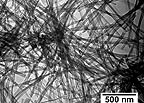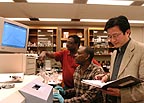May 23, 2007
Researcher's efforts get boost from NSF
CARBONDALE, Ill. -- The webs Ling Zang spins are made of fibers thousands of time smaller than a spider's, and far more sensitive.
That's because he's not hunting insects; he's snagging the molecules that indicated the presence of explosives.
An assistant professor in the Department of Chemistry and Biochemistry at Southern Illinois University Carbondale, Zang recently received a grant from the National Science Foundation worth more than a half-million dollars to continue his work on the fabrication of organic-based nanowires. The NSF is funding Zang's research proposal through its CAREER awards program, which is aimed at promising scholars and helps establish them through funding their research at high levels.
Zang's laboratory includes four graduate students, one post-doctoral student, three joint graduate students he shares with other researchers and a few undergraduate students. He is quick to credit them.
"This is a CAREER award, but I see it as an award for my whole group of students," Zang said. "Without their hard work, I can't do anything. I'm so proud of them."
The five-year award, totaling $592,000, comes on the heels of a one-year $100,000 exploratory grant, which showed the promise of Zang's research.
"Dr. Zang is extremely deserving of this recognition. His research in nanotechnology and nano-scale imaging is at the forefront of his field and is routinely published in premier scientific journals," said Gary R. Kinsel, professor and chair of the Department of Chemistry and Biochemistry. "Clearly, the award of the NSF CAREER grant contributes enormously to the reputation of our department, which is already home to four NSF CAREER award winners, and to the research preeminence of SIUC."
Zang's work focuses on three areas, all related to developing a new generation of extremely sensitive sensing devices based on nanotechnology. Nanotechnology involves the development of materials that are around one-billionth of a meter in size.
The infinitesimally small threads Zang works with are actually strings of molecules built in specific geometries. The small physical size allows them to act as a super-fine filter that can catch single molecules from explosives such as TNT or poisonous substances, such as hydrazine, as they float through the air.
With ongoing concerns about security, the technology could be a vast improvement over current sensors in terms of sensitivity to extremely low levels of telltale molecules. Future research also may improve the selectivity of such instruments, which refers to its ability to detect various substances.
Zang's grant will fund research on synthesizing molecules with improved sensitivity and selectivity used as building blocks for the threads for nanowires. He also will experiment with different geometric structures for nanowires, looking for optimal performance. Zang also will use the grant to explore marrying two types of sensors — optical and electronic — into a new hybrid sensing technology known as optoelectronic sensing.
Zang collaborates with an organic chemist, Jeff Moore, at the University of Illinois, who makes specially functionalized molecules. Zang then uses those molecules to fabricate the nanowires in his laboratories at Neckers Building on the SIUC campus.
"This is a newer technology that would provide better sensitivity and minimize problems like having false positives," said Zang, who arrived at SIUC four years ago. "As you can imagine, you don't want many false positives when you're dealing with explosives."
If TNT is in the area, however, Zang's nanowires can smell it. For instance, a landmine buried beneath soil emits about 40 parts per trillion into the atmosphere. Zang has evidence the materials he fabricates can detect levels below 10 ppt.
The detection happens when a TNT molecule lands on the matrix of nanowires and "quenches" its inherent fluorescent characteristics, which can in turn be detected by the electronics package with which it is mated.
Another type of nanowire with which Zang is experimenting uses a different approach to detect poisons such as hydrazine, a gas used in submarine environments and rocket fuel.
Zang earned his doctorate at the Chinese Academy of Sciences in Beijing. He earned his bachelor of science degree from the Department of Chemistry at Tsinghua University, in Beijing.
Earlier this year, Zang also received a $40,000 grant from the American Chemical Society's Petroleum Research Fund.

Caption 1 Below

Caption 2 Below
Caption 1: So tiny – This picture, taken with an electron microscope, shows the nanowires fabricated at Southern Illinois University Carbondale by Ling Zang, assistant professor in the Department of Chemistry and Biochemistry. Zang recently received a National Science Foundation CAREER grant worth more than a half-million dollars to continue his research on organic-based nanowires. The materials could lead to extremely sensitive explosives and poison detection devices.
Photo by Jeff Garner
Caption 2: Checking results – Ling Zang, right, assistant professor in the Department of Chemistry and Biochemistry at Southern Illinois University Carbondale, works in his laboratory with graduate students Kaushik Balakrishnan, left, and Tammene Naddo, center, at the Neckers Building on the SIUC campus. Zang recently received a National Science Foundation CAREER grant worth more than a half-million dollars to continue his research on organic-based nanowires. The materials could lead to extremely sensitive explosives and poison detection devices.
Photo by Jeff Garner
